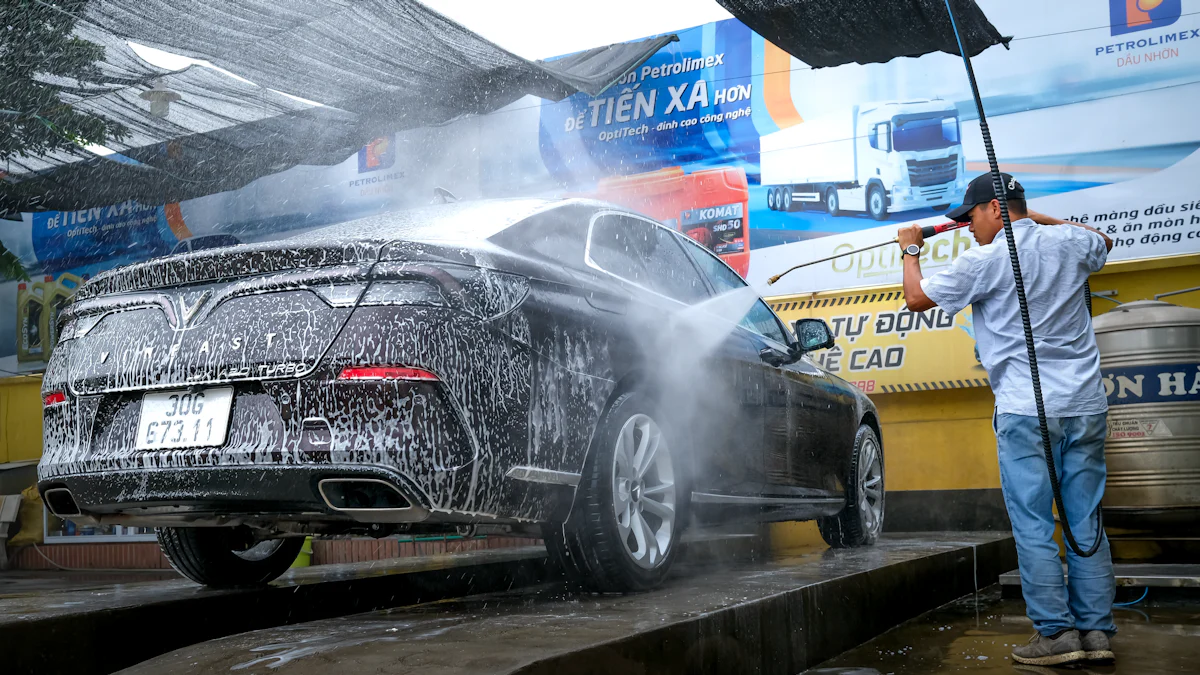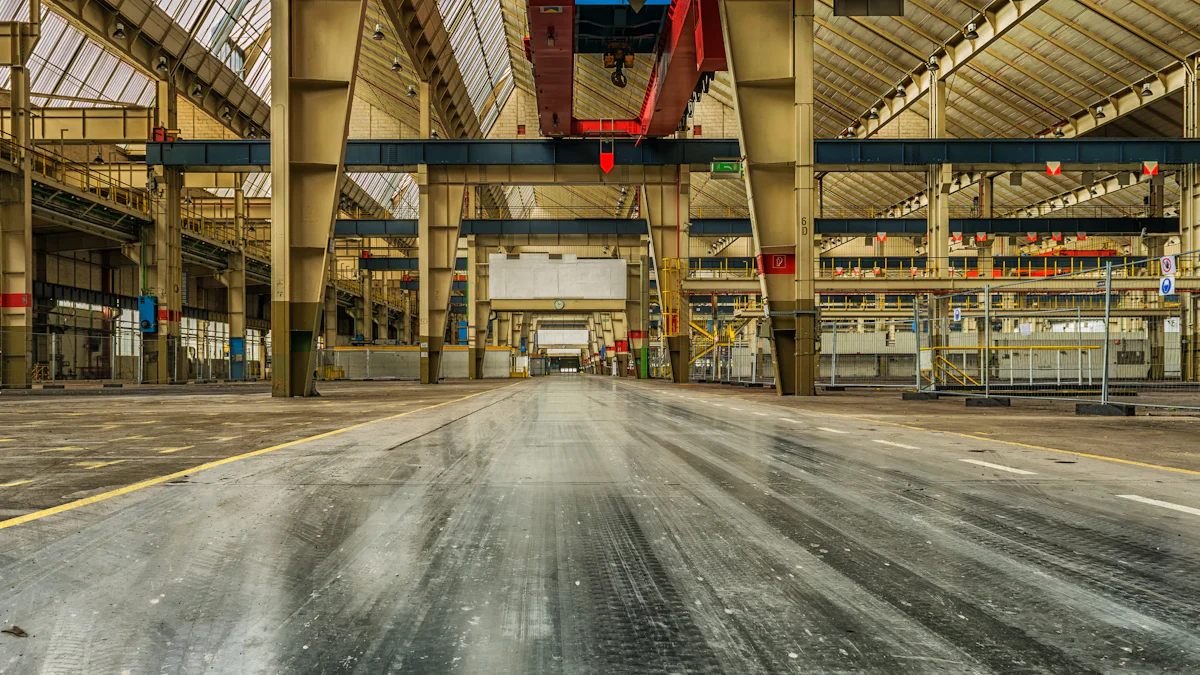
Lebenslauf Si Beschichtung zeichnet sich durch eine leistungsstarke Lösung für Industrien aus, die Haltbarkeit und Präzision erfordern. Diese Beschichtung bildet sich durch ein Verfahren namens chemisches Aufdampfen, wobei gasförmige Chemikalien auf eine feste Siliziumkarbidschicht reagieren. Das Ergebnis ist eine Beschichtung mit außergewöhnlicher thermischer Beständigkeit, chemischer Stabilität und Verschleißschutz. Seine einzigartigen Eigenschaften machen es unverzichtbar in anspruchsvollen Anwendungen wie Luft- und Halbleiterbau. Durch das Verständnis, wie diese Beschichtung hergestellt wird, können Sie das Know-how und die Technologie hinter seiner Kreation schätzen.
Wichtigste Erkenntnisse
- Lebenslauf Die SiC-Beschichtung wird durch einen präzisen chemischen Aufdampfvorgang erzeugt, was zu einer dauerhaften und leistungsstarken Siliziumkarbidschicht führt.
- Die richtige Substratauswahl und die gründliche Reinigung sind entscheidend für eine effektive Haftung und Qualität der Beschichtung.
- Die Kalibrierung von Geräten und die Durchführung von Testläufen sind wesentliche Schritte, um Fehler zu verhindern und einheitliche Ergebnisse während des Abscheidungsprozesses zu gewährleisten.
- Die Steuerung von Reaktionsbedingungen wie Temperatur und Gasdurchsatz ist für die Erzielung der gewünschten Schichtdicke und Eigenschaften von entscheidender Bedeutung.
- Post-Deposition-Behandlungen, einschließlich kontrollierter Kühlung und Qualitätsinspektionen, verbessern die Haltbarkeit und Funktionalität der Beschichtung.
- Lebenslauf SiC Coating ist in Industrien wie Luft- und Halbleitern aufgrund seiner außergewöhnlichen thermischen Beständigkeit und chemischen Stabilität weit verbreitet.
- Die Anpassung der Beschichtung durch optionale Finishing-Prozesse ermöglicht es, spezifische Anwendungsanforderungen zu erfüllen, so dass es eine vielseitige Lösung.
Vorbereitungsphase für die CVD SiC Beschichtung

Die Vorbereitungsphase legt die Grundlage für einen erfolgreichen CVD SiC Coating-Prozess. Jeder Schritt in dieser Phase sorgt dafür, dass Substrat und Geräte für eine präzise Abscheidung bereit sind. Die richtige Vorbereitung minimiert Fehler und erhöht die Qualität der Endbeschichtung.
Substratauswahl und Reinigung
Die Wahl des richtigen Substrats ist kritisch. Sie müssen ein Material auswählen, das hohen Temperaturen und chemischen Reaktionen während des Beschichtungsprozesses standhält. Gemeinsame Substrate sind Metalle, Keramik und Graphit. Jedes Material bietet einzigartige Eigenschaften, die für bestimmte Anwendungen geeignet sind.
Sobald Sie das Substrat auswählen, wird die Reinigung wesentlich. Verunreinigungen wie Staub, Fett oder Rückstände können den Beschichtungsprozess stören. Bei Reinigungsverfahren handelt es sich oft um Ultraschallbäder, chemische Lösungsmittel oder Plasmareinigung. Diese Techniken entfernen Verunreinigungen und schaffen eine unberührte Oberfläche für die Beschichtung effektiv zu haften.
Oberflächenbearbeitungstechniken
Oberflächenvorbereitung geht über die Reinigung hinaus. Es beinhaltet die Modifikation des Substrats, um die Haftung zu verbessern und eine gleichmäßige Beschichtung zu gewährleisten. Techniken wie mechanisches Polieren oder Sandstrahlen glätten Unregelmäßigkeiten und verbessern Oberflächentextur. In manchen Fällen wird durch chemisches Ätzen eine Mikro-Niveaurauhigkeit erzeugt, die eine bessere Haftung zwischen dem Substrat und der Siliziumcarbidschicht fördert.
Sie müssen auch die Geometrie des Substrats berücksichtigen. Komplexe Formen können zusätzliche Vorbereitungsschritte erfordern, um eine gleichmäßige Beschichtung Abdeckung zu gewährleisten. Die richtige Oberflächenvorbereitung wirkt direkt auf die Haltbarkeit und Leistung der CVD SiC Beschichtung.
Ausrüstungsaufbau und Kalibrierung
Der Anlagenaufbau ist ein entscheidender Schritt in der Vorbereitungsphase. Sie müssen sicherstellen, dass alle Komponenten des chemischen Aufdampfsystems korrekt funktionieren. Dazu gehören die Reaktionskammer, das Gasabgabesystem und Heizelemente. Regelmäßige Wartung und Inspektion verhindern Betriebsstörungen während des Prozesses.
Kalibrierung sorgt für Präzision. Sie müssen Temperaturregler, Gasdurchflussraten und Druckeinstellungen kalibrieren, um die spezifischen Anforderungen des Beschichtungsprozesses zu erfüllen. Eine genaue Kalibrierung garantiert konsistente Ergebnisse und verhindert Fehler in der Endbeschichtung.
Vor Beginn des Abscheidungsprozesses führen Sie einen Testlauf durch. Dies hilft, mögliche Probleme zu identifizieren und Ihnen Anpassungen zu ermöglichen. Ein gut vorbereitetes System sorgt für einen reibungslosen Übergang zur nächsten Phase des CVD SiC Coating Prozesses.
Depositionsprozess in CVD SiC Beschichtung

Der Abscheideprozess ist das Herz der Schaffung einer hochwertigen CVD SiC Coating. Diese Phase beinhaltet eine präzise Kontrolle über chemische Reaktionen, um die Bildung einer einheitlichen und dauerhaften Siliziumkarbidschicht zu gewährleisten. Das Verständnis der Schritte und Bedingungen dieses Prozesses hilft Ihnen, die fortschrittliche Technologie dahinter zu schätzen.
Überblick über die Methode zur chemischen Verdampfung
Die chemische Aufdampfung (CVD) ist ein hochentwickeltes Verfahren, das gasförmige Vorstufen in eine feste Beschichtung verwandelt. Während dieses Prozesses erhitzen Sie das Substrat innerhalb einer Reaktionskammer auf eine bestimmte Temperatur. In die Kammer eingebrachte gasförmige Chemikalien reagieren an der Oberfläche des Substrats. Diese Reaktionen führen zur Abscheidung einer dünnen, festen Schicht aus Siliciumcarbid.
Mit dieser Methode können Sie die Dicke und Zusammensetzung der Beschichtung mit bemerkenswerter Präzision steuern. Die Fähigkeit, einheitliche Schichten zu schaffen, macht CVD ideal für Anwendungen, die Hochleistungsbeschichtungen erfordern. Durch die Mastering dieser Methode, können Sie konsequente Ergebnisse für auch die anspruchsvollsten industriellen Bedürfnisse zu erreichen.
Werkstoffe und Gase, die im Prozess eingesetzt werden
Die verwendeten Materialien und Gase spielen eine entscheidende Rolle beim Erfolg des CVD-Prozesses. Methyltrichlorsilan (MTS) ist ein gemeinsamer Vorläufer zur Herstellung von Siliciumcarbidbeschichtungen. In Kombination mit Wasserstoffgas zersetzt sich MTS bei hohen Temperaturen zu Siliciumcarbid. Diese Reaktion gibt auch Nebenprodukte wie Salzsäure frei, die sicher verwaltet werden müssen.
Sie müssen die Reinheit der Gase gewährleisten, um Verunreinigungen zu vermeiden. Verunreinigungen können die Qualität der Beschichtung beeinträchtigen und zu Defekten führen. Die Wahl von Materialien und Gasen hängt von den spezifischen Anforderungen der Anwendung ab. Beispielsweise können einige Verfahren zusätzliche Gase benötigen, um die Eigenschaften der Beschichtung zu verändern.
Reaktionsbedingungen und Parameter
Die Reaktionsbedingungen bestimmen die Effizienz und Qualität der CVD SiC Coating. Temperatur, Druck und Gasdurchflussraten sind die wichtigsten Parameter, die Sie steuern müssen. Die Substrattemperatur liegt typischerweise zwischen 1000° C und 1500°C, je nach den gewünschten Beschichtungseigenschaften. Die Beibehaltung einer stabilen Temperatur sorgt für konsequente chemische Reaktionen.
Auch der Druck innerhalb der Reaktionskammer wirkt sich auf den Abscheidevorgang aus. Niederdruck-CVD-Systeme werden häufig verwendet, um eine bessere Gleichmäßigkeit und Haftung zu erreichen. Die Gasmengen müssen sorgfältig kalibriert werden, um die richtige Balance der Reaktionspartner zu gewährleisten. Zu viel oder zu wenig Gas kann die Reaktion stören und zu unebenen Beschichtungen führen.
Die Überwachung dieser Parameter während des Prozesses ist unerlässlich. Erweiterte Sensoren und Steuerungssysteme unterstützen Sie bei optimalen Bedingungen. Durch Feinabstimmung dieser Variablen können Sie Beschichtungen mit außergewöhnlichen Leistungsmerkmalen herstellen.
Mechanismus der Silikon-Karbid-Formation
Die Bildung von Siliciumcarbid während des CVD-Prozesses beruht auf genauen chemischen Reaktionen. Sie beginnen mit der Einführung gasförmiger Vorläufer, wie Methyltrichlorsilan (MTS) und Wasserstoff, in die Reaktionskammer. Diese Gase wirken bei hohen Temperaturen, typischerweise zwischen 1000° C und 1500°C, um den Abscheidevorgang einzuleiten. Die Hitze bricht die MTS-Moleküle ab und löst Silicium und C-Atome. Diese Atome verbinden sich auf der Oberfläche des Substrats zu einer festen Schicht aus Siliziumkarbid.
Die Reaktion erfolgt in einer kontrollierten Umgebung, um die Gleichmäßigkeit zu gewährleisten. Die beheizte Oberfläche des Substrats wirkt als Katalysator und fördert die chemische Bindung von Silizium und Kohlenstoff. Diese Verklebung schafft eine kristalline Struktur, die der Beschichtung seine Festigkeit und Haltbarkeit verleiht. Das Verfahren produziert auch Nebenprodukte wie Salzsäure, die Sie sicher entfernen müssen, um die Reinheit der Beschichtung zu erhalten.
Das Wachstum der Siliziumkarbidschicht hängt vom Gleichgewicht der Reaktionspartner ab. Sie müssen die Gasdurchflussraten und Reaktionszeit sorgfältig regulieren, um die gewünschte Dicke und Zusammensetzung zu erreichen. Eine stetige Vorläuferversorgung sorgt für eine kontinuierliche Abscheidung, während eine präzise Temperaturregelung Fehler wie Risse oder unebene Schichten verhindert. Durch diese Bedingungen können Sie eine hochwertige CVD SiC Beschichtung mit außergewöhnlichen Leistungsmerkmalen herstellen.
Post-Deposition Behandlung der CVD SiC Beschichtung
Die Nachpositionsbehandlungsphase gewährleistet die Haltbarkeit und Funktionalität der CVD SiC Coating. Diese Stufe verfeinert die Beschichtung, eliminiert mögliche Fehler und bereitet sie auf ihre beabsichtigte Anwendung vor. Durch diese Schritte können Sie die Leistung und Zuverlässigkeit der Beschichtung verbessern.
Geregelte Kühlung zur Vermeidung von thermischem Stress
Die Kühlung des beschichteten Substrats erfordert eine sorgfältige Aufmerksamkeit. Schnelle Temperaturänderungen können thermische Belastungen verursachen, die zu Rissen oder Verkettungen in der Siliziumkarbidschicht führen. Um dies zu vermeiden, müssen Sie einen kontrollierten Kühlvorgang durchführen. Durch die allmähliche Reduzierung der Temperatur können Beschichtung und Substrat ohne Beschädigung eingestellt werden.
Sie können spezielle Kühlsysteme verwenden, um die Rate der Temperatursenkung zu regulieren. Diese Systeme halten eine gleichmäßige Kühlung über die gesamte Oberfläche und sorgen für gleichbleibende Ergebnisse. Die Überwachung des Kühlprozesses ist unerlässlich. Jede Abweichung kann die strukturelle Integrität der Beschichtung beeinträchtigen. Die kontrollierte Kühlung verhindert nicht nur Fehler, sondern erhöht auch die Langzeitstabilität der Beschichtung.
Inspektions- und Qualitätskontrollmethoden
Die Inspektion spielt eine wichtige Rolle bei der Überprüfung der Qualität der CVD SiC Coating. Sie müssen die Beschichtung für Gleichmäßigkeit, Dicke und Haftung untersuchen. Erweiterte Werkzeuge wie Rasterelektronenmikroskope (SEM) und optische Profilometer helfen Ihnen, Oberflächenunregelmäßigkeiten und Defekte zu erkennen.
Zerstörungsfreie Prüfverfahren, wie Ultraschallprüfung oder Röntgenbeugung, ermöglichen es Ihnen, die innere Struktur der Beschichtung zu beurteilen, ohne Beschädigungen zu verursachen. Diese Techniken sorgen dafür, dass die Beschichtung den gewünschten Spezifikationen entspricht. Regelmäßige Qualitätskontrollen in dieser Phase helfen Ihnen, Probleme frühzeitig zu identifizieren und zu adressieren.
Sie sollten auch Adhäsionstests durchführen, um zu bewerten, wie gut die Beschichtung auf dem Substrat haftet. Schlechte Adhäsion kann zu Peeling oder Flocken führen, wodurch die Wirksamkeit der Beschichtung reduziert wird. Durch gründliche Inspektionen können Sie ein hochwertiges Produkt garantieren, das den Industriestandards entspricht.
Optionales Finishing für bestimmte Anwendungen
Einige Anwendungen erfordern zusätzliche Finishing-Schritte, um die Eigenschaften der Beschichtung anzupassen. Das Polieren der Oberfläche kann die Glätte verbessern und Reibung reduzieren, was für Bauteile in hochpräzisen Maschinen wesentlich ist. Eine Ätzung oder Texturierung kann erforderlich sein, um die Leistung der Beschichtung in bestimmten Umgebungen zu verbessern.
Sie können auch Sekundärbeschichtungen oder Behandlungen anwenden, um die Eigenschaften der Siliziumkarbidschicht zu ändern. Beispielsweise kann die Zugabe einer Schutzschicht die Beständigkeit gegen extreme Bedingungen erhöhen. Diese optionalen Finishprozesse hängen vom Verwendungszweck und den Anforderungen der Applikation ab.
Durch die Anpassung der Beschichtung durch Veredelung können Sie die einzigartigen Anforderungen verschiedener Branchen erfüllen. Diese Flexibilität macht CVD SiC Coating zu einer vielseitigen Lösung für anspruchsvolle Umgebungen.
Anwendungen und Vorteile der CVD SiC Beschichtung
Industrielle Anwendungen in Luft- und Raumfahrt, Halbleitern und mehr
Sie können CVD SiC Coating in einer Vielzahl von Branchen aufgrund seiner außergewöhnlichen Eigenschaften finden. In der Luft- und Raumfahrt schützt sie kritische Komponenten vor extremen Temperaturen und rauen Umgebungen. Jet-Engine-Teile und Raumfahrzeuge-Systeme profitieren von seiner Fähigkeit, thermische Belastung und Widerstand Verschleiß zu widerstehen. Diese Beschichtung sorgt für Zuverlässigkeit in Hochleistungsanwendungen, bei denen Ausfall nicht möglich ist.
In der Halbleiterindustrie spielt CVD SiC Coating eine wichtige Rolle bei der Herstellung von Prozessen. Es bietet eine Schutzschicht für Geräte, die korrosiven Chemikalien und hohen Temperaturen ausgesetzt sind. Seine chemische Stabilität gewährleistet Präzision und Konsistenz, die für die Herstellung fortschrittlicher elektronischer Geräte unerlässlich sind. Sie können auch seine Verwendung in Waferträgern und anderen Werkzeugen sehen, die Haltbarkeit und Sauberkeit erfordern.
Neben Luft- und Halbleitern dient diese Beschichtung Industrien wie Automobil-, Energie- und Medizintechnik. Es erhöht die Lebensdauer von Komponenten unter harten Bedingungen, wie sie in Kraftwerken oder chemischen Verarbeitungsanlagen gefunden werden. Seine Vielseitigkeit macht es zu einer wertvollen Lösung für jede Anwendung, die überlegene Leistung und Zuverlässigkeit erfordert.
Vorteile: Dauerhaftigkeit, Thermische Beständigkeit und chemische Stabilität
Lebenslauf SiC Coating bietet unübertroffene Haltbarkeit. Sie können sich darauf verlassen, Oberflächen vor Verschleiß zu schützen, auch in den anspruchsvollsten Umgebungen. Seine Härte sorgt für lang anhaltende Leistung, reduziert den Bedarf an häufigen Ersatz oder Reparaturen. Diese Haltbarkeit führt zu Kostenersparnis und verbesserter Effizienz für Ihren Betrieb.
Der thermische Widerstand ist ein weiterer wesentlicher Vorteil. Die Beschichtung hält ihre Integrität bei extrem hohen Temperaturen, so dass sie ideal für Anwendungen mit intensiver Hitze. Sie können darauf vertrauen, dass es konsequent funktioniert, sei es in Luft- und Raumfahrt-Motoren oder Industrieöfen. Seine Fähigkeit, thermische Spannung zu handhaben, verhindert Rißbildung oder Verformung, sicherer Betrieb.
Die chemische Stabilität setzt diese Beschichtung auseinander. Es widersteht Korrosion von Säuren, Laugen und anderen aggressiven Substanzen. Diese Eigenschaft macht es in Industrien unverzichtbar, in denen die Exposition gegenüber harten Chemikalien unvermeidbar ist. Sie können darauf zählen, um Geräte zu schützen und Leistung zu erhalten, auch in anspruchsvollen chemischen Umgebungen.
Durch die Wahl der CVD SiC Coating erhalten Sie Zugang zu einer Lösung, die diese Vorteile kombiniert. Seine einzigartigen Eigenschaften verbessern die Leistung, Sicherheit und Langlebigkeit von Komponenten in verschiedenen Branchen. Ob Sie Schutz vor Hitze, Verschleiß oder Chemikalien benötigen, diese Beschichtung liefert Ergebnisse, die Sie abhängen können.
Die Reise der Schaffung von CVD SiC Coating beinhaltet drei kritische Phasen: Vorbereitung, Abscheidung und Post-Deposition Behandlung. Jede Phase erfordert Präzision und Liebe zum Detail, um eine hochwertige Beschichtung zu gewährleisten. Dieser Prozess spielt eine wichtige Rolle in Industrien wie Luft- und Halbleitern, wo Haltbarkeit und Leistung wesentlich sind. Indem Sie diese Technologie beherrschen, tragen Sie zu Fortschritten in Hochleistungsanwendungen bei. Das für diesen Prozess erforderliche Know-how unterstreicht die Bedeutung von Fachkräften und fortschrittlichen Geräten bei der Bereitstellung zuverlässiger Ergebnisse.
FAQ
Was ist CVD SiC Coating?
CVD-SiC-Beschichtung bezeichnet eine durch chemische aufdampfung erzeugte siliziumkarbidschicht.
Warum wird CVD SiC Coating gegenüber anderen Beschichtungen bevorzugt?
Sie sollten CVD SiC Coating für seine überlegenen Eigenschaften wählen. Es bietet außergewöhnliche thermische Beständigkeit, Verschleißschutz und chemische Stabilität. Diese Eigenschaften machen es ideal für Industrien wie Luft- und Halbleiter, wo Leistung und Zuverlässigkeit kritisch sind.
Welche Materialien können als Substrate für die CVD SiC Coating dienen?
Sie können verschiedene Materialien als Substrate, einschließlich Metalle, Keramik und Graphit verwenden. Die Wahl hängt von der Anwendung und der Fähigkeit des Substrats, hohe Temperaturen und chemische Reaktionen während des Beschichtungsprozesses zu widerstehen.
Wie dick ist die typische CVD SiC Beschichtung?
Die Dicke der CVD SiC Beschichtung variiert je nach Anwendung. Sie können die Dicke während des Abscheidungsprozesses steuern, typischerweise von einigen Mikrometern bis zu mehreren hundert Mikrometern. Diese Flexibilität ermöglicht die Anpassung an spezifische Bedürfnisse.
Ist der CVD SiC Coating Prozess umweltfreundlich?
Das Verfahren erfordert eine sorgfältige Verwaltung von Nebenprodukten wie Salzsäure. Mit der richtigen Handhabung und fortschrittlichen Ausrüstung können Sie die Umweltauswirkungen minimieren. Viele Hersteller implementieren Sicherheitsmaßnahmen, um die Einhaltung der Umweltstandards zu gewährleisten.
Kann CVD Si Beschichtung auf komplexe Formen aufgebracht werden?
Ja, Sie können komplexe Formen mit dem CVD-Prozess beschichten. Die richtige Oberflächenvorbereitung und präzise Steuerung der Reaktionsbedingungen sorgen für eine gleichmäßige Deckung auch bei komplizierten Geometrien. Diese Fähigkeit macht es für Komponenten mit anspruchsvollen Designs geeignet.
Wie stellen Sie die Qualität der CVD SiC Coating sicher?
Qualitätssicherung beinhaltet gründliche Inspektion und Prüfung. Sie können Werkzeuge wie Rasterelektronenmikroskope und zerstörungsfreie Prüfverfahren verwenden, um die Gleichmäßigkeit, Haftung und strukturelle Integrität zu überprüfen. Regelmäßige Qualitätskontrolle gewährleistet, dass die Beschichtung den Industriestandards entspricht.
Welche Branchen profitieren am meisten von CVD SiC Coating?
Branchen wie Luft- und Raumfahrt, Halbleiter, Automotive und Energie profitieren maßgeblich von der CVD SiC Coating. Seine Haltbarkeit, thermische Beständigkeit und chemische Stabilität machen es für Anwendungen in rauen Umgebungen unverzichtbar.
Wie lange dauert der CVD SiC Coating Prozess?
Die Dauer hängt von Faktoren wie Substratgröße, gewünschte Schichtdicke und Reaktionsbedingungen ab. Während der Prozess mehrere Stunden dauern kann, sorgt die präzise Steuerung für eine hochwertige Beschichtung, die die Zeitinvestitionen rechtfertigt.
Kann CVD Si Beschichtung für spezielle Anwendungen angepasst werden?
Ja, Sie können die Beschichtung durch optionale Finishing-Schritte anpassen. Polieren, Ätzen oder Hinzufügen von Sekundärschichten können die Eigenschaften der Beschichtung auf einzigartige Anforderungen zugeschnitten. Diese Anpassungsfähigkeit macht sie zu einer vielseitigen Lösung für verschiedene Branchen.